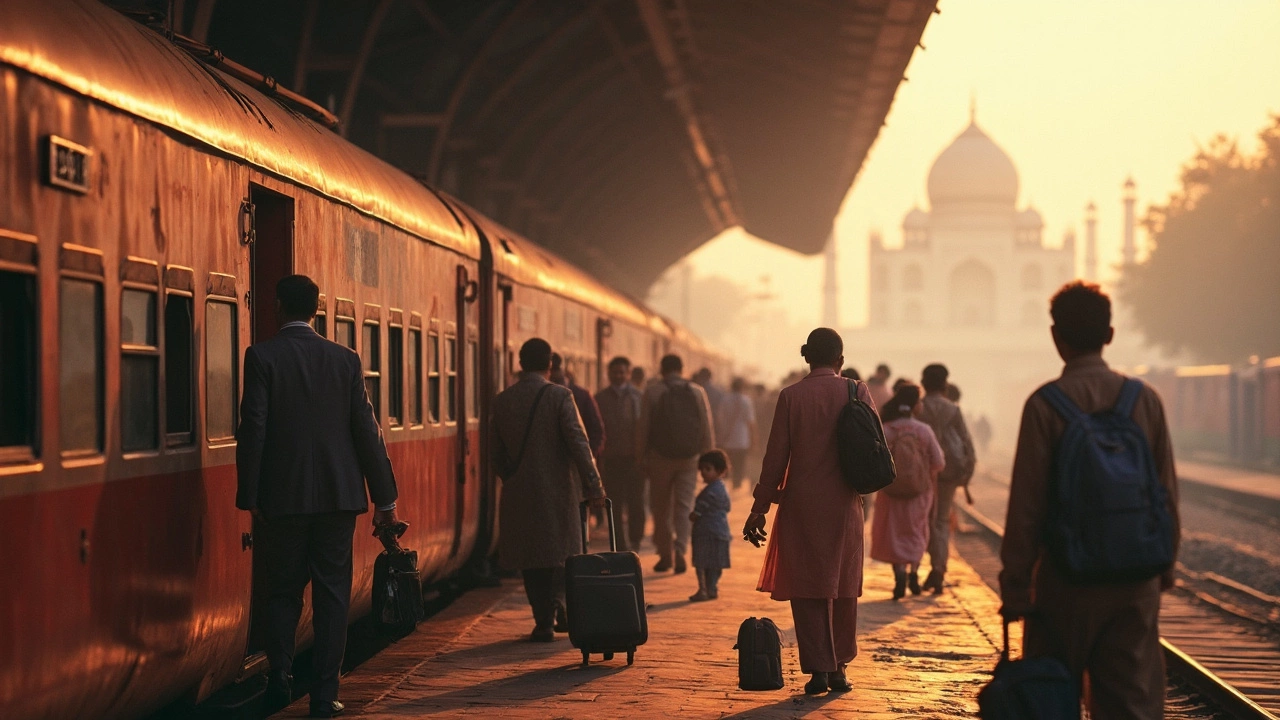Delhi to Taj Mahal: Your No-Nonsense Guide to Getting There
 May, 29 2025
May, 29 2025
That first glimpse of the Taj Mahal hits different when you realize it’s only about 230 kilometers from Delhi. But here’s the thing: if you have no idea how to get there or which option suits your style (or your wallet), the trip can get confusing. You have solid choices—express trains, highways built for speed, buses for budget travelers, and even a helicopter if you want to brag a bit.
Booking early is smart, especially if you’re looking at those fast trains like the Gatimaan or Shatabdi Express. These aren’t just quick—they’re clean and actually stick to the schedule, which is honestly rare for Indian trains. If road trips are more your vibe, driving down the Yamuna Expressway is probably the smoothest highway in North India. Got bags and a group? A private car is way less hassle than the bus, and you won’t get herded around random stops. But, if every rupee counts, buses leave from Anand Vihar all day. They’re not fancy but they get you to Agra without burning a hole in your pocket.
No matter how you go, watch out for early morning or late night departures—Delhi traffic can turn your plan into a crawl if you’re not careful. And hey, don’t just show up at the Taj without tickets. Book online to skip those long lines, or you’ll be roasting in the sun before you even see the marble.
- The Fastest Ways to Reach the Taj Mahal
- Picking the Right Train: Tips and Timings
- Driving from Delhi to Agra: What You Need to Know
- Making Your Taj Mahal Visit Count
The Fastest Ways to Reach the Taj Mahal
If you’re starting out in Delhi and want to get to Agra to see the Taj Mahal without wasting time, you have a few proven options. The fastest way is by train, but road trips can be quick too—if you pick the right route and time.
The Gatimaan Express is the top pick for speed. It leaves from Hazrat Nizamuddin Station in Delhi and gets you to Agra in just about 100 minutes. It’s clean, there’s Wi-Fi, and you get a meal. The Shatabdi Express takes a bit longer—around two hours—but it’s dependable and comfortable. Both usually leave in the morning, so you can be at the Taj before lunchtime. Trains drop you at Agra Cantt station, which is a quick 15-20 minute ride from the monument. Buy tickets ahead—these trains fill up, especially in winter and school holidays.
If you’re thinking about driving, the Yamuna Expressway is your best bet. It’s a modern, six-lane toll road connecting Delhi and Agra directly. With light traffic, you can reach Agra in about three hours. This road is smooth, well-marked, and has rest stops for coffee or snacks, but it’s cashless for toll payments, so make sure your FASTag is active if you’re renting or driving yourself.
Buses can work if you’re watching your budget. The best bet is the government-operated Volvo or AC buses from Anand Vihar ISBT in Delhi, not the random private ones that crowd up around Metro stations. These Volvos are faster and safer, taking around four hours on a good day.
For folks who want to make a memory (and don’t mind splurging), there are helicopter tour operators that’ll whisk you to Agra from Delhi. It’s not cheap, but you’ll land just outside the city in less than an hour, with great views of the countryside—and yes, a pretty awesome story for Instagram.
Quick tip: Whatever you pick, set out early, and double-check timings—Delhi traffic and Indian Railways delays are no joke. Google Maps is usually accurate, so keep it handy on travel day.
Picking the Right Train: Tips and Timings
So, you want the fastest, easiest, and least stressful way to the Taj Mahal? Trains are hard to beat. Honestly, the Delhi to Agra route is stacked with good options, but a little planning can save a ton of hassle.
The Gatimaan Express is hands down the quickest. It leaves Hazrat Nizamuddin Station in Delhi at 8:10 AM and rolls into Agra Cantt at 9:50 AM, shaving your travel time to just 100 minutes. Seats are comfy, there’s free breakfast, and the staff doesn’t leave you guessing. Shatabdi Express is the old favorite, leaving from the same station at 6:00 AM and pulling in around 8:00 AM. If you’re an early riser, that train gets you to Agra in time for the sunrise at the Taj.
Now, don’t bother hunting for tickets at the station if you can avoid it. You can book your seat on the IRCTC website or via apps like MakeMyTrip. The faster trains—especially on weekends and holidays—sell out fast, so try to book at least a week before. AC Chair Car is the sweet spot: not pricey but way more comfortable than Sleeper Class.
- Hazrat Nizamuddin (NZM) and New Delhi (NDLS) stations are closest to central Delhi. Don’t get confused with Old Delhi (DLI), which is way more chaotic.
- Agra Cantt (AGC) station is the main stop for the Taj and is only about 6 km from the actual site. Grab a prepaid taxi or auto at the stand—ignore touts at the exit.
- Keep a digital copy of your ticket and an ID; train conductors check for both. Don’t risk it with dodgy agents or old-school paper tickets without your name printed.
- If you want a late return, check out the evening Gatimaan or Shatabdi trains—they get you back to Delhi before midnight, so you’re not stranded.
Trains can get cold with the AC blasting, especially in winter, so carry a light jacket. And don’t expect WiFi to work the whole way. Focus on staring out the window, or better yet, get your Taj Mahal tickets online while you ride.

Driving from Delhi to Agra: What You Need to Know
Driving from Delhi to Agra is honestly super straightforward, thanks to the Yamuna Expressway. This six-lane highway changed the game—before it opened up in 2012, the same drive could take up to 6 hours on the old NH2. Now, most folks make it in 3 to 4 hours if they leave at a normal hour and don’t take long breaks.
The expressway is about 165 km long and doesn’t really have random stops or crowded stretches like other highways around Delhi. If you’re into numbers, check this out:
| Route | Distance (km) | Average Drive Time | Toll Fee (Car, One Way) |
|---|---|---|---|
| Yamuna Expressway | 165 | 3 hours | ₹415 (as of 2024) |
| NH2 (Old Route) | 210 | 5-6 hours | Low to none |
Your GPS will almost always pick Yamuna Expressway as the default. Start from South or East Delhi and you can get to the on-ramp at Greater Noida with a straight shot.
Here’s what you should keep in mind if you’re taking your own car or hiring one:
- Delhi to Agra is all about timing. Early morning works best—less traffic, open toll booths, and you reach before Agra heats up.
- Make sure your car has a full tank. There’s only one main fueling station on the entire expressway, around halfway (about 95 km in). Don’t gamble with a nearly empty tank.
- If you’re not keen to drive, booking a private cab is easy online or through apps. For 2025, most Delhi–Agra round-trip taxi rentals cost somewhere between ₹4500–7000, depending on the car.
- The expressway is camera-monitored—speed limits matter. Official limit for cars is 100 km/h. Cops do hand out fines, especially after the Surajpur toll plaza.
- Snacks and toilets? Use the dedicated rest plaza just after Jewar. It’s basic but better than nothing. Grab a chai, stretch your legs, and move on.
On weekends and holidays, be ready for longer queues at the toll booth near Agra and slower traffic as you approach city limits. Keep at least an hour buffer if you have Taj tickets for a fixed entry time. Oh, and Agra itself is crowded! The closer you get to the monument, the messier the roads—book a hotel with parking or choose a parking lot outside and take an e-rickshaw for the last mile.
Making Your Taj Mahal Visit Count
First things first: the Taj Mahal is closed every Friday. Shows up, gates locked, not fun—so double-check your days. Early mornings are honestly the best. Not only is it cooler, but crowds are way smaller and your pics won’t be filled with random people in the background. The east and west gates open just before sunrise, so try to be there when the doors swing open. Don’t forget your ID—passport or Aadhaar card, because security at the Taj Mahal is strict and they do check.
Bags bigger than a purse aren’t allowed inside. There are lockers near the entry points, but keeping it light saves time and hassle. Water bottles, a compact camera, and your phone are all fine. No tripods unless you’re a pro with some kind of press pass. Food, tobacco, and lighters are a definite no-go—they’ll make you toss them at the entrance.
If you’re counting pennies, grab a ticket online from the official ASI website. Foreigners and locals pay different rates (foreigner tickets get you a shoe cover, a bottle of water, and a little map). Kids under 15 walk in free, which is rare in India. The main mausoleum—the big marble building—is where you’ll want to spend most of your time. You need a special extra ticket to actually get up close. Regular entry doesn’t always cover that.
- Stay at least 30 minutes after sunrise or around sunset—the light makes the marble almost glow, and you won't get this effect any other time of day.
- If photos are your thing, the best vantage is in the garden straight in front, where you get that classic reflection shot with the long pool. But keep moving, because everyone else wants the same spot.
- Watch out for people offering to "guide" you. Stick to registered guides, or use the official ASI audio guide. Unofficial guides will say anything—once, one guy told me the Taj Mahal was made of white cheese. Seriously.
- The mosque on the west side is quieter and cool inside—if you need a break from the sun, duck in there for a breather.
The Taj Mahal isn’t just a check mark on your list. It’s the centerpiece of Delhi to Agra travels for a reason, and you want to make sure you do it right. Bring patience, good walking shoes, and a fully charged phone—every bit helps. And if you find yourself exhausted, ask for a cycle rickshaw back to the parking area. Beats walking, trust me—especially if you’ve been up since 4 a.m. to beat the crowds.